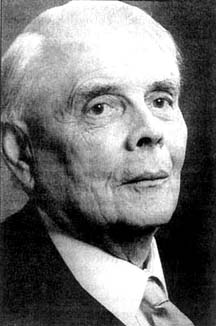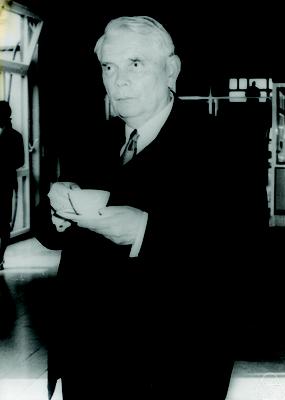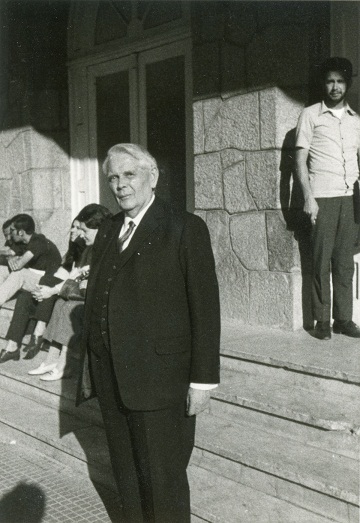<Back to Index>
- Mathematician
Wolfgang Krull, 1899
PAGE SPONSOR



Wolfgang Krull (26 August 1899 - 12 April 1971) was a German mathematician working in the field of commutative algebra.
He was born in Baden-Baden, Imperial Germany and died in Bonn, West Germany.
His doctoral students include Wilfried Brauer and Jürgen
Neukirch.
He is known for the Krull dimension, the Krull topology, Krull's intersection theorem, Krull's principal ideal theorem, the Krull ring, Krull's theorem and the Krull - Schmidt theorem.
Wolfgang Krull's father was Helmuth Krull and his mother was Adele Siefert Krull. Helmuth Krull had a dentist's practice in Baden-Baden and it was in that town that Krull attended school.
After graduating from secondary school in 1919 he entered the University of Freiburg. It was the custom in those days for students in Germany to move around various universities during their period of study and Krull was no exception. He spent time at the University of Rostock before moving to Göttingen in 1920.
From 1920 to 1921 he studied at Göttingen with Klein but was most influenced by Emmy Noether. He attended Klein's seminar in the session 1920-21 and he then returned to Freiburg and presented his doctoral thesis on the theory of elementary divisors in 1922. Ring theory results from this thesis have recently been found important in the area of coding theory.
Appointed as an instructor at Freiburg on 1 October 1922 he was promoted to extraordinary professor in 1926. He remained there until 1928 when he moved to Erlangen. His inaugural address on becoming a full professor at Erlangen was one which says much of how Krull saw mathematics. He saw the role of a mathematician as:
... not merely ... finding theorems and proving them. He wants to arrange and group these theorems together in such a way that they appear not only as correct but also as imperative and self - evident. To my mind such an aspiration is an aesthetic one and not one based on theoretical cognition
If Emmy Noether had the greatest influence on the topics which Krull would spend his life researching, it can be seen from this inaugural address that it was Klein who had the greatest influence on Krull's large scale view of mathematics. In 1929 he married Gret Meyer and they would have two daughters.
The ten years Krull spent in Erlangen were the most productive period of his career. Schoeneborn writes:
The years Krull spent as a full professor in Erlangen were the high point of his creative life. About thirty - five publications of fundamental importance for the development of commutative algebra and algebraic geometry date from this period.
At Erlangen he was involved in university life as well as concentrating on his research, being elected Head of the Faculty of Science.
In 1939 Krull left Erlangen to take up a chair at Bonn. However, his career was disrupted by the Second World War which began shortly after Krull was appointed to the University of Bonn. During the war he undertook war duties, working in the naval meteorological service. When his war service had ended in 1946, Krull took up again his post at the University of Bonn and he would remain there for the rest of his life. In this final period of his career Krull continued his high level of productivity (he wrote 50 papers in his post war years in Bonn) and also broadened his mathematical interests. He continued:
... his earlier studies, but also dealt with other fields of mathematics: group theory, calculus of variations, differential equations, Hilbert spaces.
Krull's first publications were on rings and algebraic extension fields. In 1925 he proved the Krull - Schmidt theorem for decomposing abelian groups of operators. He then studied Galois theory and extended the classical results on Galois theory of finite field extensions to infinite field extensions. In passing from the finite to the infinite case Krull introduced topological ideas.
In 1928 he defined the Krull dimension of a commutative Noetherian ring and brought ring theory into in new setting in which he was able to show that the principal ideal theorem held. Perhaps the reason that the idea of the Krull dimension is such a natural concept is that it encapsulates in an abstract setting the analogues of geometric dimensions. The principal ideal theorem:
... was quickly recognized as a decisive advance in Noether's programme of emancipating abstract ring theory from the theory of polynomial rings.
Krull carried his work forward, defining further concepts which are today central to modern research in ring theory. In 1932 he defined valuations which are today known as Krull valuations. He then wrote the remarkable treatise Ideal Theory which remains a beautiful introduction to ring theory but is simply a theory built from the results that Krull had himself proved. One could say that Krull had achieved the goal he had in some sense set himself in his Erlangen address and arranged his theory to be self evident.
Another major topic in ring theory is the study of local rings, that is rings having a unique maximal ideal, and they are used in the study of local properties of algebraic varieties. The concept was introduced by Krull in 1938 and his fundamental results were developed into a major theory by mathematicians such as Chevalley and Zariski.
He supervised 35 doctoral students, and rather remarkably, 32 of these were students which he supervised after the end of World War II. Gray writes that Krull's papers are:
... marked by the profundity of his ideas, the rigor of his proofs, and also by a strong aesthetic sense.
Indeed much of modern ring theory is still following the path which Krull took, building on the foundations which Emmy Noether had laid.